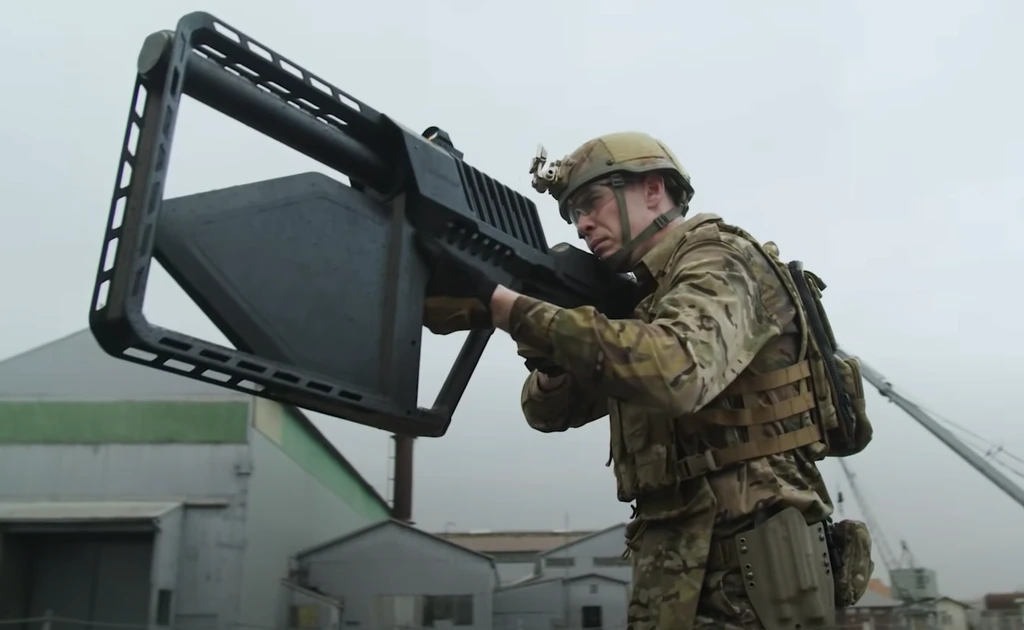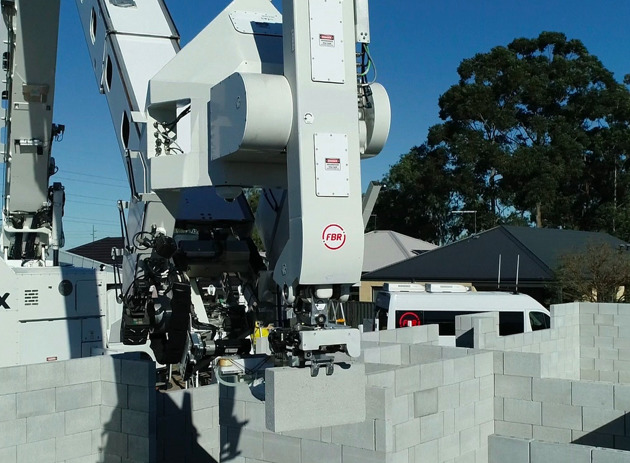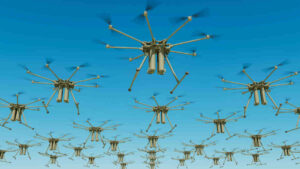Here’s a bunch of weird, cool and wonderful tech stocks on the ASX you probably didn’t know existed

Or something like it. Picture: Getty Images
- PPK’s Boron Nitride Nanotubes are 100 times stronger than steel
- Electro Optic Systems’ laser tech can track space debris and shoot down drone swarms
- X-Reality Group plans to use its VR tech for defence applications
Most of the tech stocks on the ASX are a bit, well, dry, but we’ve sifted through to find the weird, whacky, and wonderful ones for your Wednesday perusal.
This company sits sort of adjacent to the semiconductor market with its Micro-electromechanical systems (MEMS) device which is small and can withstand temperatures so low that it can be used to ID samples in harsh environments like cryogenic samples.
Yep, we’re talking IVF samples, clinical trials, cell therapies, vaccines, population cryobanking – in case we need to repopulate the Earth after a zombie apocalypse – basically any market that requires ultra-low temperature ID and traceability.
Recently, the company even nabbed a new Japanese Patent: Device, System and Method for Temperature Limit Indication and Detection of Temperature-Sensitive Items.
MD Andrew McLellan has previously said there are well over 300 million high value bio samples that are stored, and preserved and processed in minus 196°C environments “and this is a well over $600 million annual target market for us.”
The $14.96m market cap company had $2.79m as at 31 March 2022.
Who doesn’t love lasers? Not to mention it’s a US$25bn market, with around US$380 million of that for industrial applications.
Laser diode player BluGlass is focused on its remote plasma chemical vapour deposition (RPCVD) technology to build gallium nitride (GaN) laser diodes.
They’re used in the industrial welding that goes in your telephone, medical diagnostics tools, and electric vehicles.
And in April the $33.16m market cap company picked up a semiconductor fab in Silicon Valley for a cheap $2.5 million and is building laser diodes at 405, 420 and 450 nanometres – with plans to launch six or seven products this year.
Cash at end of the March quarter was $4,382 million.
This artificial intelligence (AI) chip developer says its Akida neuromorphic processor mimics human brain processing.
Last month fresh chairman Antonio Viana compared it to a security camera where IR detects movement, turns the camera on and alerts you to some form of movement – but you have to figure out what it is.
“Where neuromorphic processing can come in would be a security camera that is ‘smart enough’ to know what is causing the movement… and not just send an alert that says ‘something’ is in the frame… but instead says ‘it is a dog’, ‘it is a human’. And even better, to know who that human is – ‘run away, your spouse’s family just showed up!’” he said.
The company already has a bunch of patents under its belt and the plan now is commercialisation.
BRN ended the March quarter with US$31.2M in cash and has a market cap of $1.75b.
This company uses AI to protect drones – thus the name – with its DroneGun able to scramble the controller-inputs on airborne drones to render them incapacitated.
Or there’s its DroneSentry-X product which uses sensors to detect and disrupt unmanned aerial systems (UAS) moving at any speed after being masted to vehicle roof racks or other fixed applications.
And in March, CEO and MD Oleg Vornik said they’d received some urgent enquiries by various NATO countries for large purchases as drone defence has become front of mind with the Russian invasion of Ukraine.
The company secured around $3.8 million for a two-year AI contract with the Australian Department of Defence in 2021 and soon its products could be used to counter explosive devices, with the recent partnership with Allen Vanguard.
Vornick said many of DroneShield’s customers have mission sets that requite both counter unmanned aerial platforms (C-UAS) and counter improvised explosive device (C-IED) solutions so by combining them, the two entities can provide a more complete offering.
And in April, DroneShield teamed up with Nearmap (ASX:NEA) – who provide city-scale 3D content, artificial intelligence data sets, geospatial tools, and high-resolution aerial imagery in Australia, New Zealand, and North America.
The $95.15m market cap company had $8m in the bank as at 31 March.

ELECTRO OPTIC SYSTEMS (ASX:EOS)
Everyone loves space almost as much as they love lasers, and Electro Optic Systems combines the best of both worlds – with a satellite in orbit that uses its laser sensor technology to track space debris and facilitate communications.
The $276.17m market cap company boasts early-stage defence systems like laser physics, advanced optics, precision control systems, space domain sensors and communications technologies, and remote operated combat vehicles.
Just last month, EOS used a laser to disable Group 1 drones at an effective rate of 20 drones/minute at ranges beyond 1,000 metres – which established a new benchmark for neutralising swarm drone attacks.
And in March, the company nabbed conditional finance support from Export Finance Australia for up to US$80 million of debt funding for the initial satellite communications constellation (Block-0a) to be launched by its wholly owned subsidiary, SpaceLink.
SpaceLink will basically provide connectivity between Earth observation satellites and back to the ground – and they’re under construction with the plan to be active in 2024.
At 31 March 2022 EOS held $28.1 million in total available cash.
BCT, BLG, BRN, DRO and EOS share prices today
This company makes robots that lay bricks. The Hadrian X can apparently build structural walls faster, safer, more accurately and with less wastage than traditional manual methods.
But it could be some time before it’s out in the field.
In the March quarter the company signed a Memorandum of Understanding (MoU) with Liebherr-Mischtechnik GmbH who will provide its expertise on structural and mechanical design, control systems and automation, design for manufacturing, as well as providing practical feedback on the operation of heavy machinery in construction environments in applicable markets.
And that’s just phase 1 which is expected to take around two years, the company says.

A close third to lasers and aerospace players are defence tech companies – like unmanned aerial vehicles (UAVs) specialists such as Orbital Corp who make integrated engine systems for tactical UAVs, like its ScanEagle 3 model.
Last month the $26.38m market cap company signed an MoU with US-based Anduril, which was founded in 2017 by Palmer Luckey, the designer of the Oculus Rift, and founder of Oculus VR which was acquired by Facebook.
Anduril aims to transform allied defence capabilities by fusing AI with the latest hardware technology and the companies are teaming up to collaborate to “advance the next generation of military technology.”
OEC also manufactures aeroengines for Boeing from its Perth-based and US facilities and is developing a hybrid propulsion system for a vertical take-off and landing UAV with defence technology company Northrop Grumman.
It’s probably not some super-secret Top Gun stealth tech, but we like to think it is.
This company’s Boron Nitride Nanotubes (BNNT) produces a ‘fibre’ 100 times stronger than steel but as light as carbon fibre, super flexible, more thermally conductive than copper, and able to sustain high temperatures of up to 1000C without degrading.
The tech has applications from aviation, automotives and aerospace to ballistic armour, defence, electronics and beyond.
That’s probably good for Li-S Energy’s (ASX:LIS) disruptive battery technology – PPK’s most commercially advanced technology incubation project that just secured funding under the Federal Government’s Trailblazer University Project.
LIS will receive up to $5m in federal co-investment over the next four years to further develop its lithium sulphur batteries that could, for example, allow EVs to drive longer and drones to fly for hours between charges, as well as mobile phones you don’t have to plug in for a week.
PPK retains 50.2% ownership of Li-S, which has been on a roll since its successful spin-out IPO last September.
Li-S already has a collaboration with Boeing subsidiary Insitu Pacific to integrate and test its battery technology in a range of drones. That followed the announcement of a partnership with Janus Electric to power around 400 electric trucks.
With its broader focus on BNNTs, PPK has formed a strategic alloys JV with manufacturing solutions company Amaero International (ASX:3DA) and Deakin University to incorporate the high-strength and super flexible fibres into Amaero’s High Operating Temperature Aluminium Alloys (HOT Al).
PPK also has a material stake (45%) in Craig International Ballistics too, which is a leading supplier of body armour to the Australian Defence Force and Police Forces.
As if that wasn’t enough to be getting on with, PPK also has a strategic 20% stake in Advanced Mobility Analytics Group Pty Ltd, an artificial intelligence SaaS product that’s basically a traffic management safety system that can even predict accidents.
Wait, there’s more.
The $229.47m market cap company is also working on commercial manufacturing plans for its ~60% owned subsidiary, White Graphene Ltd.
White Graphene is also known as Boron Nitride Nanosheets, flat 2D sheets with microscopic thickness that share many properties of BNNT such as high strength, thermal stability up to 900C, excellent thermal conductivity, electrical insulation, and radiation shielding.
The company has a large-scale base/precious metals project in the Western Deserts of the Officer Basin – but it also has an artificial intelligence and robotics company called Stealth Technologies and a Nanocube Memory Ink project which is a liquid transparent ink containing billions of tiny nanometer scale cube-shaped particles.
Last month it announced a breakthrough in how electricity is generated with research partner The University of New South Wales (UNSW) developing a world-first battery pack that aims to harvest ampere-hour range of electrical charge solely from moisture in the air.
The 36cm2 cells will be printed onto flexible plastic using green, sustainable, safe materials, with results expected to be available in Q3 FY22.
It could have potential in the US$10 billion electronic skin patch market – which is forecast to grow to US$30 billion by 2031.
The company has a market cap of $68.4m.
VECTION TECHNOLOGIES (ASX:VR1)
This company is all aboard the metaverse bandwagon with its VR tech.
Late last year VR1 unveiled its FrameS Metaverse release, as part of its app integration with Webex by Cisco.
The new features will enable organisations to autonomously build immersive metaverses, dynamic 3D worlds where people can participate in meetings from anywhere in the world.
These 3D settings will be embedded to the WebEx by Cisco platform, the leading solution for video conferencing with over 590 million monthly participants.
But there are a few other stocks pursuing the metaverse space, including blockchain gaming company Playside Studios (ASX:PLY) and iCandy Interactive (ASX:ICI), which has launched itself into the metaverse world by acquiring 100% of shares in Lemon Sky Studios.
FBR, OEC, PPK, SOR, and VR1 share prices today
Another VR company – but one with its eyes on the defence prize.
Formerly known as Indoor Skydive Australia (IDZ), XRG operates indoor skydiving facilities across Australia, with its customer base ranging from individual skydivers, corporates as well as the military.
But since rebranding to XRG earlier this year, the company has turned its focus on virtual reality (VR) and metaverse experiences.
In August last year, XRG acquired Red Cartel, one of Australia’s leading experts in VR, AR, and XR technologies, and has various retail VR venues across Australia.
But even more interesting is the company’s plan to target the defence VR market – combining free roam virtual reality, integration of weapons and equipment and the ability to create buildings, rooms and environments.
Essentially, the company’s operator arm will provide the end user with the ability to train and conduct mission rehearsals using their own equipment combined with Operator’s hardware and software.
XRG is trialling its tech with small focus groups within the Special Forces units in Australia and the US, and then plans to initially target specialised military units followed by law enforcement organisations.
The company has a market cap of $14.29m.
Staying on the defence thematic, this company makes mini X-ray tech, which is also used in airport security – but more recently has been deployed to the front lines in Ukraine.
In the March quarter, MX1 secured $0.8 million of Micro-X Rover sales into the Ukraine to provide additional medical imaging capability for Ukrainian soldiers and civilians injured in the war.
The orders were funded by a US-based charity for use in temporary medical facilities following attacks on Ukrainian health infrastructure.
The company is also working on its ‘Argus’ IED X-ray camera product, “with a number of customers already expressing strong interest in conducting Argus trials, including the United States Federal Bureau of Investigation, military EOD organisations and some of the larger state police bomb squads,” the company said.
The $73.83 market cap company had a cash balance of $16.1 million as at 31 March 2022.
In the age of COVID, a cough-screening app like the one biotech player ResApp has developed could be super handy.
Basically, the machine learning technology could identify coughs from audio recorded using the smartphone’s in-built microphone.
The company says the technology will provide a ‘rule-out screening test’ for COVID-19 at scale globally, which could eventually phase out PCR tests,
ResApp surprised the market in April after revealing that Pfizer wants to buy out the company at 11.5c a share, valuing it at around $100m – and is currently in voluntary suspension pending an update about the proposed acquisition.
XRG, MX1 and RAP share prices today
At Stockhead we tell it like it is. While Orbital Corp, PPH Group and Strategic Elements are Stockhead advertisers, they did not sponsor this article.
UNLOCK INSIGHTS
Discover the untold stories of emerging ASX stocks.
Daily news and expert analysis, it's free to subscribe.
By proceeding, you confirm you understand that we handle personal information in accordance with our Privacy Policy.








